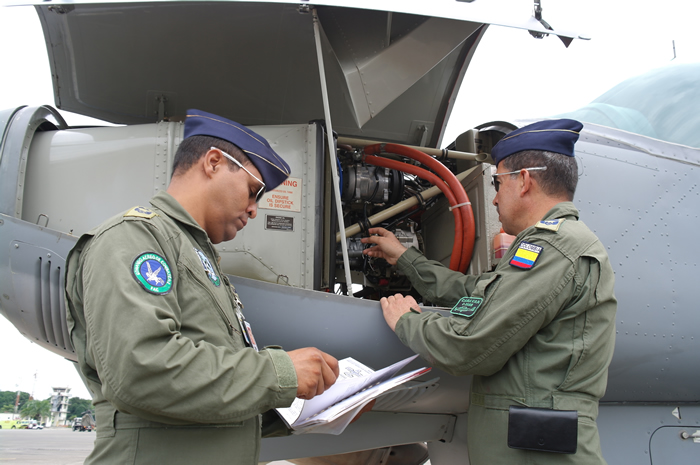Optimization of a type knsb solid fuel engine for experimental rocketry
DOI:
https://doi.org/10.18667/cienciaypoderaereo.502Keywords:
Experimental Rocketry, KNSB, Rocket Motor, Solid PropellantAbstract
This article shows in a general way the optimization process for a solid fuel engine based on a mixture of Potassium Nitrate and Sorbitol (KNSB) with a Bates type grain configuration, generally used in low power experimental rocketry. In this process, the maximum thrust is selected for the least amount of mass required, indicating the estimated size of the most efficient motor through multiple iterations, where from the initial range of thrust values the amount of propellant mass required is calculated. Additionally, through the graphical estimation of the second derivative of the thrust relation to the mass, an efficiency limit is established where the increase of the propellant amount must represent at least an increase greater than 0.5% in the slope of that relationship. Finally, a model of the motor assembly schematized by computer aided design software is proposed.
Downloads
References
Apogee Components (2004), Rocket engine clasification system explained. Issue 131. Colorado. Apogee. 3 p.
Charlery R., Renouf M. Saulot. A. Daly N. Berthier Y. Experimental and numerical modeling of the ignition of solid propellant. En: Tribology International. Volumen 75. pp 150
Ishitha K, Ramakrishna P.A. (2014). Studies on the Role of Iron Oxide and Copper Chromite in Solid Propellant Combustion. En: Combustion and Flame. Volumen 161. Pp. 2717-2728
https://doi.org/10.1016/j.combustflame.2014.03.015
Meyerowitz G. (2013) Experimental Rocket Motor Safety and Standards Manual. YPL Yale University. 11 p.
Mg. Brown P. C. (1973). A Guide to Amateur Rocketry. Fort Sill. Ocklahoma. US. Army Field Artillery School. 5 p.
Nakka R., Garofalo S. (2014). Teoría sobre motores cohete de propelente sólido. En: www.nakka-rocketry.net
Singh S. (2013). Solid Rocket Motor for Experimental Sounding Rockets. En:Advances in Aerospace Science and Applications. Volumen 3 (N.3). pp. 199-208
Sutton G.P., Biblarz O., (2000). Rocket Propulsion Elements. Nueva York. Wiley-Intersicence Publication. 6 pp.
Valera Muñoz C. (2012). Diseño de la Tobera de un Cohete con el Método de las Caracterísitas y Comparación con Código CFD. (Trabajo de Grado). (2012). Escuela Técnica Superior de Ingenierías Industrial y Aeronáutica de Terrassa. Universidad Politécnica de Cataluña. 8 p.
Verma S., Ramakrishna P.A., (2013) Dependence of density and burning rate of compiste solid propellant on mixer size. En: Acta Astronáutica. Volumen 93. pp 130 -137
https://doi.org/10.1016/j.actaastro.2013.07.016
Yaman H, Celik V, Degirmenci E. (2014) Experimental Investigation of the factors affecting the burn rate of solid rocket propellants. En: Fuel. Volumen:115. pp 794-803
https://doi.org/10.1016/j.fuel.2013.05.033
Yildirim H.C., Özúpek S. (2011) Structural Asessment of a Solid Propellant Rocket Motor: Effects of Aging and Damage. En:Aerospace Science and Technology. Volumen 15. Pp 635-641

Downloads
Published
Issue
Section
License
Assignment of Copyrights
Authors assign Ciencia y Poder Aéreo journal the exclusive rights (reproduction, distribution, public communication, and transformation) to exploit and commercialize their work, in whole or in part, in all the formats and modalities of present or future exploitation, in all languages, throughout the life of the work and throughout the world.
All contents published in Ciencia y Poder Aéreo journal are licensed under a Creative Commons Attribution 4.0 International License, whose complete information is available at http://creativecommons.org/licenses/by/4.0/
Under the terms of this license, users are free to download, print, extract, archive, distribute and publicly communicate the content of articles, provided that proper credit is granted to authors and Ciencia y Poder Aéreo, scientific journal of the Graduate School of the Colombian Air Force. Except when otherwise indicated, this site and its contents are licensed under a Creative Commons Attribution 4.0 International License.
For other uses not considered under this license it is required to contact the Director or the Editor of the journal at the e-mail address cienciaypoderaereo1@gmail.com.
The Graduate School of the Colombian Air Force and this publication are not responsible for the concepts expressed in the articles, including the metadata or the affiliation stated by authors. This is the full responsibility of the authors.





















